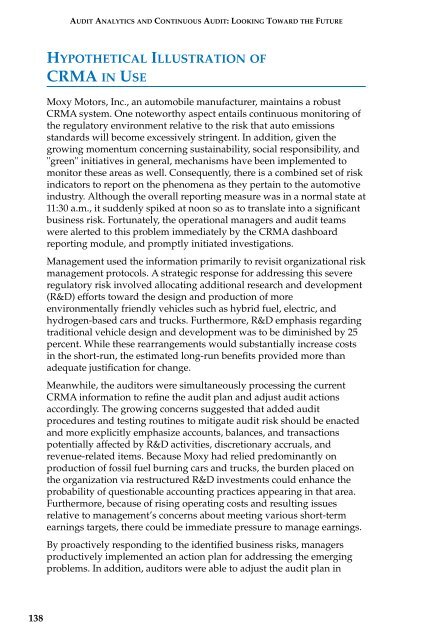AUDIT ANALYTICS AUDIT
1JWn3ix
1JWn3ix
Create successful ePaper yourself
Turn your PDF publications into a flip-book with our unique Google optimized e-Paper software.
<strong>AUDIT</strong> <strong>ANALYTICS</strong> AND CONTINUOUS <strong>AUDIT</strong>:LOOKING TOWARD THE FUTURE<br />
HYPOTHETICAL ILLUSTRATION OF<br />
CRMA IN USE<br />
Moxy Motors, Inc., an automobile manufacturer, maintains a robust<br />
CRMA system. One noteworthy aspect entails continuous monitoring of<br />
the regulatory environment relative to the risk that auto emissions<br />
standards will become excessively stringent. In addition, given the<br />
growing momentum concerning sustainability, social responsibility, and<br />
"green" initiatives in general, mechanisms have been implemented to<br />
monitor these areas as well. Consequently, there is a combined set of risk<br />
indicators to report on the phenomena as they pertain to the automotive<br />
industry. Although the overall reporting measure was in a normal state at<br />
11:30 a.m., it suddenly spiked at noon so as to translate into a significant<br />
business risk. Fortunately, the operational managers and audit teams<br />
were alerted to this problem immediately by the CRMA dashboard<br />
reporting module, and promptly initiated investigations.<br />
Management used the information primarily to revisit organizational risk<br />
management protocols. A strategic response for addressing this severe<br />
regulatory risk involved allocating additional research and development<br />
(R&D) efforts toward the design and production of more<br />
environmentally friendly vehicles such as hybrid fuel, electric, and<br />
hydrogen-based cars and trucks. Furthermore, R&D emphasis regarding<br />
traditional vehicle design and development was to be diminished by 25<br />
percent. While these rearrangements would substantially increase costs<br />
in the short-run, the estimated long-run benefits provided more than<br />
adequate justification for change.<br />
Meanwhile, the auditors were simultaneously processing the current<br />
CRMA information to refine the audit plan and adjust audit actions<br />
accordingly. The growing concerns suggested that added audit<br />
procedures and testing routines to mitigate audit risk should be enacted<br />
and more explicitly emphasize accounts, balances, and transactions<br />
potentially affected by R&D activities, discretionary accruals, and<br />
revenue-related items. Because Moxy had relied predominantly on<br />
production of fossil fuel burning cars and trucks, the burden placed on<br />
the organization via restructured R&D investments could enhance the<br />
probability of questionable accounting practices appearing in that area.<br />
Furthermore, because of rising operating costs and resulting issues<br />
relative to management’s concerns about meeting various short-term<br />
earnings targets, there could be immediate pressure to manage earnings.<br />
By proactively responding to the identified business risks, managers<br />
productively implemented an action plan for addressing the emerging<br />
problems. In addition, auditors were able to adjust the audit plan in<br />
138


